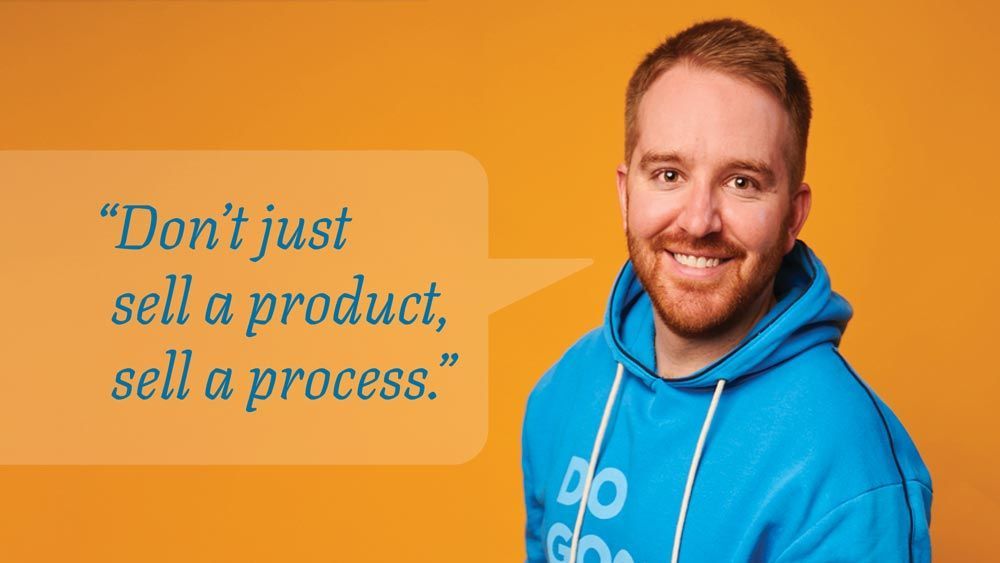You Own the Brand. I Own the Branding.
What is a brand? What is branding? Why does it matter?
This episode of the Everybody Brands podcast is Part One of an extended conversation with Andy Starr, Managing Partner of Level C, and Brian Sooy, founder of Aespire and Level C Certified Brand Strategist and StoryBrand Guide.
“We believe that the brand is defined by and owned by you. Branding is what we do as the owner of the business; it’s what I do to influence you.”
Andy Starr is the managing partner of Level C, an education program teaching principles of modern brand to business professionals. Andy co-founded Level C and with international brand expert and author Marty Neumeier.
Andy calls himself a “provocateur-for-hire” at the intersection of education, business, and brand. He helps clients outmaneuver competition and conditions in their markets, make marketing/advertising/PR/content work better, land stronger, and drive real results.
Because he’s a provocateur, you can understand why I invited Andy for a conversation about brand and business on the Everybody Brands podcast. (These snippets are edited for clarity)
What’s it like working with Marty Neumeier?
Andy: Working with Marty is how I’ll use the word I’ve used for the past several years. It’s bananas. It’s bananas; especially I am still a fanboy. One of the things that I loved about his thinking before I even spoke to him before I met him was it’s just wholly original. He’s so simple in the way he frames a complicated idea.
He is all about originality and simplicity. People always ask him what, what it what have I learned from him since working with him. And the main thing that’s always the same, I have learned to simplify, simplify, simplify, and prioritize originality and original thinking, whether it’s just concepting something by myself working collaborating with other people, even with him
Brian: On your LinkedIn profile, you wrote what you believe and how you do it. There are five statements. The first one is, “Marketing is the push, branding is the pull.” Why do you believe this to be true?
Andy: In The Brand Flip, Marty wrote, “People hate being sold to, but they love to buy stuff.” Like you, I’ve read every word the chief has ever written. And of all the things he’s written, that is still one of easily the top two or three most provocative things he’s written that I’ve ever read or heard or even tried to process and wrap my arms around.
After we launched level C, one of the questions we get more than anything else is, “What’s the difference between marketing and branding?” Sometimes it’s framed a different way, “Why is branding greater than or more important than, or more valuable than marketing or vice versa?”
Marty and I talk about that all the time, in the breakfast lunches, dinners, coffees, drinks, you know, eating wheels of Canberra, cheese, and drinking bottles of rosé at his farmhouse in France. This is the stuff we talk about. I was sketching out my ideas about it one day and remembered this thing he wrote, “People hate being sold to, but they love to buy.” it’s just true.
As I was thinking about it, I found myself trying to go down that path of “brand is more important than marketing,” but then I realized that that’s not true. It’s not entirely true. What Marty and I say to our classes, we’ve said it as often as we can; branding and marketing both have roles. You can disagree with it if you want; I’m not going to fall on the sword of absolute truth, but it’s a truth that I believe in.
We would make an argument that marketing has a business role, and branding has a business role. Both branding and marketing both have equally important roles. They overlap and intertwine, and there are nuances; there are differences. I think about it through push and pull. When you get into a conversation with a business owner or a client, I found that framing it that way is simple. We’re going back to kind of Marty’s tenets. It’s simple. It’s easy to understand. It’s provocative without being scary. And I found, and I believe, that it has some sex appeal to it as an overarching concept. When we’re talking about business functions when talking about business impact,
Brian: I’ll often say marketing helps build value for the brand, but the brand retains the value. Nobody buys a business because they say, “Your marketing program is excellent. They believe it because there’s value in the brand. For example, Microsoft bought Skype and then replaced the software with its platform. They paid billions of dollars for a name, which just astounds me. That’s a great story of brand value in a name and how much Microsoft paid for it.
Is Brand a Valuable Business Asset?
There’s a lot of talk about the brand as a business asset. How can that asset be valuated? Should it be evaluated? That brings up questions you’ve asked before, “How can you have a conversation with the CEO and talk about brand strategy versus business strategy? Why are both equally important?
A brand is the consumer’s agent to the business. The brand is the bridge; that’s what brings people to the company. Business managers and business owners should ask the questions: Why should I care about the brand? Why does brand matter? Why does brand strategy matter? Why do I need to think about it just as much as business? Why is brand just as important as marketing and sales and advertising and PR?
It’s because the brand is how you get your customers? Good luck with that! If you don’t need your customers or don’t care about your customers — don’t invest in the brand — don’t manage it, don’t hire people to run it.
If people who own and are running businesses in Level C’s space, our competitors — if you will — if that’s going to be their mentality or mindset, they will minimize brand. I’m going to sit back and just kind of put my hands behind my head, put my feet up on the desk and let them do that because they won’t want marketing.
Our space is supersaturated and overcrowded with really great marketers. But in the long term, they won’t be there. We will. There are many reasons why but you know, they make it all about themselves and what Marty and I are doing and trying to do even better. That’s why we don’t plaster my face (Andy) or his face (Marty) all over our stuff. We’re not the hot pink brand, the hot yellow brand, the neon green brand with awesome, super-stylized photos of ourselves, making it all about us. We don’t have to do that. Ironically, we’re the worst marketers you have ever met, and we’re okay with that.
We believe everything we’re doing is designed for and geared for you, not for us. We don’t want to sell you anything. We don’t want to push anything on you; we want to pull you in. And at the very least, we want to make it easy for you and every student that you sat in, in the courses that you’ve taken with us; we want to make it easy for you to make a choice. That’s branding.
I’ll shut up and go to the second question that people always ask us is, “What’s the difference between brand and branding?” We’ll go right to Marty’s definition: Brand is the person’s gut feeling or perception. (Brand) The consumer defines it. You define the Level C brand, Brian. You own the brand.
If you believe you own your brand, you’re doing your marketing all wrong.
Andy: You can argue against it, around it, over it. That’s okay. It’s Marty’s philosophy. It’s Marty’s experience. It’s the tenet that we put out. It’s okay for other people to have different definitions, and other meanings or interpretations are alright. But we believe that the brand is defined by and owned by you. Branding is what we do as Level C’s business owners; it’s what I do to influence you.
The brand is yours. Branding is mine. I don’t want you to do the branding or to lead the influence; I want to have a role in that. And some people might even argue with that. Start a business, take responsibility for trying to own it grow, scale, and pay other people. And I think you’ll very quickly acquiesce to the idea that it needs there needs to be balanced. You own the brand. I own the branding. Let’s meet in the middle.
Can Your Brand be a Best kept Secret?
Brian: That is precisely how I think about brand and branding. As a small business owner, this is Aespire’s 25th year of business. I’ve outlasted dozens of other agencies and outlasted clients. We’ve always told them, “Your brand is not about you; it is about your customers and what they want from your business, and how are you going to help them achieve success or solve a problem or make a difference in the world.”
It speaks back to that it’s not about standing out it’s about being different. Branding is about influencing people by drawing them in. Our minimum viable audience will come to us and discover our company is a best-kept secret. We’re going to leverage this advantage to do precisely what they’re saying we can do (for our clients) and outmaneuver our competition. We can change the brandscape and the landscape in our category.
Andy: Cool. Exactly. That’s what we’re all about. What I think is so interesting about what we’re doing is this stuff is, so it’s super cerebral. At the same time, it demands simplicity and focus. Our favorite F word is focus, focus, focus. We don’t believe that branding can be templated or formulaic or a toolkit. You can make the argument that some of those elements can be templated, or there can be kind of a formulaic linear approach, but generally, as a business discipline, brand cannot be templated.
Brand can be disciplined — it demands discipline — and can be practiced. After enough time and practice and success and failure and shifting and personalizing and internalizing in theory, people can master the discipline of brand. We try to (at Level C) frame these principles and teach our students how to think about this stuff, rather than just how to do this stuff. You can’t teach someone how to do branding; you can teach someone how to think about brand, which will let them figure out how to approach branding.
Andy: People ask me how I got the master (Marty) to do this with me. It’s very simple. I learned to think and understand brand and his principles for myself to command them at will; I can tailor them as needed. I don’t have to rely on a template on a toolkit on a formula on a phrase on a page on a book. I command this stuff at will that lets me weaponize it, and that makes me dangerous.
Templates and toolkits, and formulas have their place. A big part of this community wants to be told how to do stuff. “Give me a list with ten bullet points, the ten things I need to do, the ten questions I need to ask for brand strategy.” Marty and I are very clear about what we stand for. All of that is in the rearview mirror. And we are doing this for people who recognize the value—being able to think about this brand in this way so you can command this stuff and weaponize this stuff so that you are more valuable and capable.
Brian: You’re right; people just want to be told how to do stuff. They want their ten lists; they want a blog article that says the ten things you can do to solve this one problem. There’s no intuition in that approach; there’s no contextualization. The discipline of branding is like the discipline of painting. Whereas you have the whole palette of colors, you have the palette; you have the medium on which you’re going put the colors; you have your choice of paint. Unless you know how watercolor interacts with paper and how to treat the paper, you’re going to end up with a mess. It takes that practice of preparation to be able to apply the paint) in a disciplined manner.
Brand and branding are different for the solopreneurs who need a referral strategy to get more business versus the multinational global corporation with multiple channels and teams, and silos. It’s so contextual, and that’s what I’m learning. I came in thinking to Level C’s credit; I’ll have this process that will be repeatable. Now I have a framework I can weaponize and apply it where needed. Because I’ve been a student of the discipline (and of Marty Neumeier) for a long time, I was able to use brand principles immediately for one client who loves the result. They feel empowered like nothing’s going to stop them now.
In Part Two, we discuss what Andy Starr believes and how he does it: “If it’s not scary, it’s not innovative. And if it’s not innovative, it’s not worth it.”
Do you have a hard time explaining what your company does or why your brand matters to people?
If you struggle to grow your business, you’re not alone. Aespire can help you create a clear message and brand that helps you grow your business. Contact us today for a consultation with a StoryBrand Certified Marketing Guide.
Get a Free Comprehensive Marketing Assessment
Stop hoping your marketing will sort itself out.
- Complete this free assessment in 15 minutes.
- Review your custom report (and schedule a 30-minute review) to diagnose what’s happening.
- Create an action plan to get your marketing back on track.







